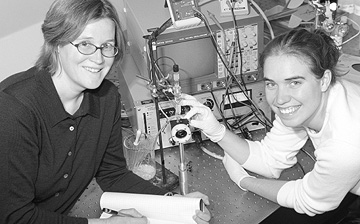“Ironclad” Research May Lead to Cleaner Water
Elise Jones-Landry ’03 spent much of last summer closeted in a second-floor laboratory in the Olin Center for Physics and Chemistry, observing the chemical interaction between iron and various clays. While performing experiments that might yield clues to cleaning up polluted groundwater or erecting more durable building foundations, she hit a formidable snag: attempts to repeat the same basic test produced wildly varying results.
After a week of side experiments and library research, she and her adviser, Barbara Balko, associate professor of chemistry, identified the culprit. The silver chloride reference electrode was contaminating the experiment; they solved the problem by substituting a different type of reference electrode.

Elise Jones-Landry ‘03 (right) looks for evidence of oxidation-reduction reactions using a potentiostat and electrochemical cell with her adviser, Barbara Balko, associate professor of chemistry.
Although she calls the delay “really frustrating,” Jones-Landry says the independent sleuthing that the problem required cemented her decision to write her senior thesis on the project. “When you take a class, everything in the lab has been done before,” says Jones-Landry, a 26-year-old senior from California. “In this research, there isn’t any answer. It’s like a puzzle that I have to figure out, and I’m the kind of person that likes the challenge.”
Jones-Landry is one of several recent students who have tasted real-world research while aiding Balko’s efforts to better understand the interaction between clay and iron. Learning about that relationship, Balko explains, could someday improve the technology that helps break down contaminants in groundwater, strengthen the clay liners used to cradle landfills, and fortify the foundations of steel-framed buildings rooted in soil.
Iron has been a common thread in Balko’s recent research. When she arrived at Lewis & Clark in 1993, Balko specialized in optical studies of semiconductor electrodes. But she segued into geochemistry during a 1996-97 sabbatical at the OGI School of Science and Engineering at Oregon Health & Science University, where she studied how permeable barriers composed of iron particles could degrade certain groundwater contaminants. Her work on these underground iron walls uncovered new insights into the mechanics of the increasingly used technology, and launched a remarkable faculty-student collaboration that resulted in the recent publication of an educational CD-ROM.
Her current research, funded in part by a three-year grant from the Petroleum Research Fund of the American Chemical Society, is an offshoot of her iron-wall inquiry. Balko is trying to deepen scientific understanding of how different types of clay react with iron on a molecular level. This research, which she began during a 2000-01 sabbatical at the Pacific Northwest National Laboratory in Richland, Washington, has potentially far-reaching consequences. For instance, she might identify and explain how a certain clay, when added to iron walls, speeds up the degradation of groundwater contaminants.
Balko, a New Jersey native who earned her PhD in physical chemistry from the University of California at Berkeley, says she’s always been concerned about the environment and the outdoors. And as a physical chemist, she adds, “I’m interested in surfaces.” Her environmentally relevant research on the electrochemistry of mineral surfaces combines those two interests. It also appeals to green-conscious Lewis & Clark students.
In fact, Jones-Landry says she was attracted to Balko’s research partly because of the environmental benefits it promises. She also sought to bolster her academic credentials. “If you want to go to graduate school, you basically need to do summer research,” says Jones-Landry, who hopes to earn a PhD in environmental, physical, or inorganic chemistry and to eventually perform lab research as a college professor or as an independent investigator.
Balko enjoys partnering with students on her research, particularly those enrolled in the John S. Rogers Science Research Program, a 10-week summer session that pairs students with Lewis & Clark science professors. “Students ask a lot of questions,” says Balko. “They often think about problems in a different way.”
Balko says she attempts to design projects that give students a firsthand look at the ups and downs of performing original lab-based research.
Jones-Landry says Balko’s approach instills an appreciation of the independent thinking required of professional chemists. “She guides me, but doesn’t necessarily give me all the answers,” says Jones-Landry. “You have to design the experiment, determine what you have to find out, and figure out how you’re going to go about doing it.”
—by Dan Sadowsky
More L&C Magazine Stories
Lewis & Clark Magazine is located in McAfee on the Undergraduate Campus.
MSC: 19
email magazine@lclark.edu
voice 503-768-7970
fax 503-768-7969
The L&C Magazine staff welcomes letters and emails from readers about topics covered in the magazine. Correspondence must include your name and location and may be edited.
Lewis & Clark Magazine
Lewis & Clark
615 S. Palatine Hill Road MSC 19
Portland OR 97219

